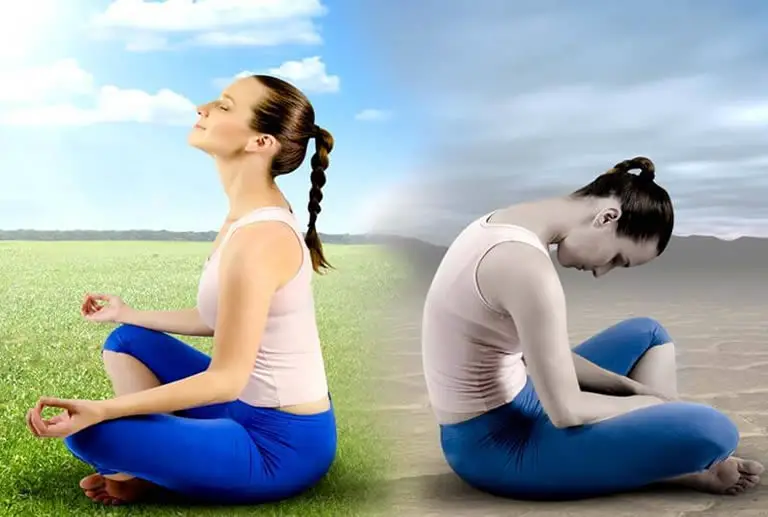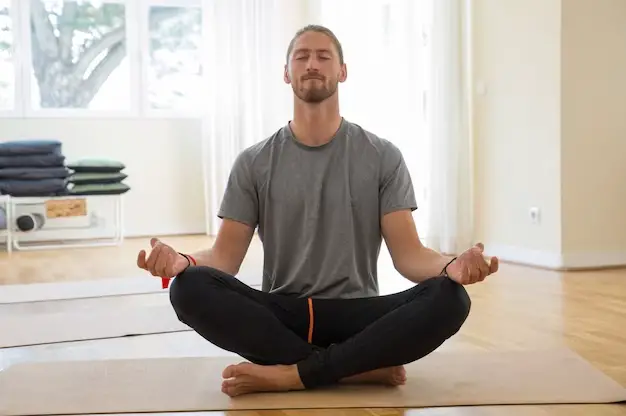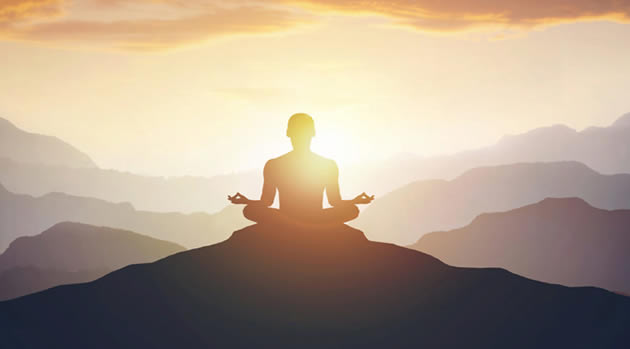
Although there seems to be a definite link between regular meditative practices and the development of lucid dreaming skills there is very little talked about the mechanics of how the two interact. Any talk there is, is either misleading or incorrect so I plan to set the record straight here.
Let’s start with the obvious question, “can you lucid dream while meditating?”.
Contents [hide]
Can You Lucid Dream While Meditating?
You can’t lucid dreaming while meditating. They are totally different states of consciousness.
You can only lucid dream when you are asleep and experiencing REM (rapid eye movement).
Once you enter REM and start lucid dreaming you are no longer meditating, you are sleeping.
Why you can’t lucid dream while meditating
It is literally impossible to lucid dream while you are meditating because the two practices are connected to completely different levels of consciousness.

To understand why you can’t experience a meditative state and a lucid dream at the same time let’s quickly look at the two disciplines, to see what they are so you can clearly identify how they differ.
The proper definition of meditation
Although meditation takes many different forms and has many different disciplines associated with it, from mindfulness and mantra meditation to Vipassana and transcendental meditation, its basic premise remains the same.
The aim of meditative practices is to calm the mind and body while creating a very definite state of consciousness and mental functioning.
The state of consciousness you wish to induce during a meditation session will depend on the particular mediation disciple you are using and your goal meditative goals.
However, regardless of what meditative practice you use rest assured that you must remain awake while you use it. All meditation techniques require that you stay awake.
You must be awake to meditate.
Your body and mind may be very relaxed and even “zoned-out” but you are still very much awake and fully conscious in the waking world while meditating.
This differs greatly from the experience of lucid dreaming.
The correct definition of lucid dreaming
Lucid dreaming is the experience of being “awake” within a dream. Although you are technically asleep, and your body is temporarily immobilized (see sleep paralysis), you are mentally alert and aware while you are dreaming.
This allows you to interact with the dream in the same way you interact with the everyday world.
Now, there are actually two types of lucid dream that I will not address in this article but if you are interested in learning more about the difference between the two read this article.
But because both types of lucid dream have the same basic structure and origin, and you aware consciously awake and aware in each one, you can assume that when I refer to lucid dreams or lucid dreaming within this article that I am referring to both types.
Lucid dreaming requires your body to be asleep because they only ever occur in a very specific stage of the sleep cycle.
Although you can dream at point during sleep, lucid dreams can only ever occur in the REM state. You can only experience REM when you are asleep.
As you fall asleep you will move through the natural sleep cycles, which I covered here, and eventually enter the REM (rapid eye movement) stage of your sleep cycle.
REM usually happens about 90 minutes after falling asleep (though there are exceptions such as when you take a nap).
Therefore, you must be sleeping in order to lucid dream.
You cannot lucid dream while you are awake because REM sleep only occurs when your body is immobilized and asleep.
The confusion between being awake and being asleep in a lucid dream occurs because when you lucid dream your mind is awake but your body is asleep.
You see a lucid dream is the same as a regular dream, at least in structure and origin. It is only how you experience it that i different.
Within a lucid dream your are consciously aware and mentally awake in the same way you are when you are going about your normal daily activities.
This is where confusion often arises between meditation and lucid dreaming. Both involve being physically relaxed and immobile but they differ greatly in all other areas.
Let me explain.
Lucid Dreaming Is Not A Form Of Meditation
Because lucid dreaming and meditation both involve consciousness-altering practices, and both require a relaxed body, many people think that they are the same or believe that they are at least very similar.
So, is lucid dreaming just another form of meditation?
Lucid dreaming is not a form of meditation. Although your body and mind will be relaxed while meditating, meditation requires you remain awake.
Lucid dreaming requires you fall asleep and enter the REM state.
Meditation and lucid dreaming are completely different physical and mental states that also rely on different levels of consciousness.
As we seen earlier in this article, in order to meditate you must be awake and consciously aware of your own physicality.
Although you can detach somewhat from your body and automatic thoughts in meditation you are still in the level of consciousness that corresponds to the state of being awake.
Whereas, in a lucid dream you must be physically asleep and must be experiencing the REM stage of sleep.
You cannot have a lucid dream unless you are physically experiencing REM sleep.
So in order to lucid dream you must first fall into the state of unconsciousness we all know as sleep. On the flip side, while meditating you must remain conscious and awake.
These two states are so opposed to one and other that falling asleep during meditation is a real problem that many meditators battle with regularly.
Can you dream while meditating?
So we have identified the differences between lucid dreaming and meditation, but what about regular dreaming? Can you dream while meditating?
You can’t dream while meditating.
Meditation and dreaming are totally different states of consciousness with different physical properties.
You can only dream when you are asleep.
You can only successfully meditate while you are awake.
There is a meditative practice known as dream yoga that involves lucid dreaming but this is something entirely different.
You simply cannot dream while meditating because dreaming requires you to be asleep.
Once you fall asleep you enter a different a state of consciousness from the one you experience while awake – even if you are meditating.

Regular dreams require you to be unconscious and asleep, while mediation requires you to be conscious and awake.
If you find that you have experienced a dream during a meditation session then be aware that you had fallen asleep and were no longer meditating.
Experiencing REM while meditating is not the same as dreaming
It is true that you can experience REM while meditating.
This rapid movement is often accompanied by deep meditation, especially if it involves some form of visualization. But, although the REM is the same in both meditation and dreaming, it does not mean the person meditating is dreaming.
They are two different states of consciousness.
REM is just a physical byproduct of functions of the brain that involve internal visual stimuli.
Contrary to popular belief, you cannot dream while awake
Just as many people wonder about the possibility of experiencing dreams while meditating many people wonder if it is possible to dream while you are awake.
You can’t dream while you are awake. You must be in a state of unconsciousness and sleep in order to dream.
The only exception is lucid dream when you are consciously/mentally awake, instead of unconscious, but your body is still asleep.
All types of dreams only ever happen when you are asleep.
Likewise, you cannot lucid dream while awake
Ok so you can’t dream while you are awake but what lucid dreaming?
In a lucid dream you are fully conscious and aware just like you are when you are going about your normal daily activities.
So, can you lucid dream while you are awake?
You can’t lucid dream while you are awake.
Lucid dreaming only happens when you experience REM (rapid eye movement) and REM only happens when you are asleep.
Although your mind is awake, your body must be asleep and immobilized when you lucid dream.
You Can Meditate In A Lucid Dream However
With all the talk about meditation and with the understanding that anything being possible in lucid dreams does that mean meditation is possible while you are asleep … can you meditate in a lucid dream?
You can mediate in a lucid dream. Tibetan dream yogis often use lucid dreams to further enhance their meditative practices.
Modern anecdotal evidence and ancient Tibetan teachings have lead lucid dreamers to the belief that lucid dream meditations are more powerful than meditations performed while awake.
In Tibet there are monks who dedicate their lives to learning how best to use lucid dreams to explore their own spirituality, the nature of life and to connect with the spiritual essence of God’s creation.
These are Tibetan Dream Yogis.
An article from lionsoar.com does a good job of briefly covering what dream yoga is. The subject is much to broad for me to go beyond merely touching on it in this article.
However, if this is a topic of interest to you, the author of the aforementioned internet article cites an excellent resource book which you may be interested in.
It really delves into this ancient practice of dream yoga and reading it can help you understand how to use lucid dreaming to enhance all areas of your meditations.
The book is titled Dream Yoga: Illuminating Your Life Through Lucid Dreaming and the Tibetan Yogas of Sleep, by Andrew Holecek (with forward by lucid dreaming pioneer Stephen LaBerge pH.d.)
If you are very interesting in exploring the ancient Tibetan techniques of dream yoga you should also check out the excellent book The Tibetan Yogas Of Dream And Sleep, by author Tenzin Wangyal Rinpoche. Though there are a ton of great resources on dream yoga you can get online if you are willing to spend a bit of time hunting around from them.
I should point out though that most books and resources on Tibetan dream yoga are more focused on the history, the esoteric aspects of lucid dreams and how to use them for spiritual growth than they are on teaching you how to actually wake up in your dreams.
You see, Tibetan monks, in all disciplines not just dream yoga, start at a very young age and learn the basics of their discipline very early.
We all know how good very young Shaolin monks are at Kung Fu, for example.
So it is also with monks who are practitioners of dream yoga.
Disciples learn how to lucid dream when they are very young and this means that the vast majority of dream yoga teachings focus more on advanced dream techniques that are employed within a lucid dream rather than techniques for becoming lucid.
Having said that, once you know how to induce a lucid dream and take control of it, dream yoga teachings get very, very interesting to explore!
Now, all this talk of meditating within a lucid dream sounds great, but how do you learn the skill of lucid dreaming in the first place?
You can also use meditation to help induce lucid dreams
Meditation has been a practice used for thousands of years by Tibetan Dream Yogis to induce lucid dreams.
By calming the body and leading the brain into a more receptive and relaxed state, with accompanying higher alertness, Yogis teach their brains to become lucid in dreams.
You can do the same.
You can use the old fashioned lucid dream yoga mediation techniques that have worked for Dream Yogis for millennia and it is very effective.
I also advise you use 21st century technology to speed things up a bit. Specific binaural beats tracks can entrain your brain to enter deep meditative states on the first listen without having to spend 20 years practicing mediation.
How to effectively learn lucid dreaming for better meditation practices
Lucid Dreaming is not some strange and esoteric skill that just a small percentage of the population is born with.
Lucid dreaming is far from rare with 55% of the population having at least one and up to 37% having at least one per month.
Because the causes of a lucid dream are completely natural and reside in states that are created by normal brain functions, and because we know how these states can be replicated by anyone that means that everyone can lucid dream.
Although the time to learn the skill will differ with each individual, everyone can learn to lucid dream.

So, it doesn’t matter whether you came to this article because you wanted to use a lucid dream to practice higher level mediations (within a realistic-feeling dreamworld) or because you simply wanted to know if lucid dreaming was just another form of meditative practice (which you now know it is).
Hopefully after reading this article you can see the many benefits that lucid dreaming has to offer. It is much more that a way to experience better meditations.
As well as being able to actually improve your meditations, by meditating within a lucid dream (which is super powerful), you can also use those dreams for other things from manifestation to time travel and a lot more in-between!
So what are you waiting for, why not learn to lucid dream today?
Consider investing the small amount needed to get trained by professionals. This specific lucid dreaming course not only teaches you how to become lucid in your dreams, it also teaches you how to become the total controlling force in those dreams.
Another lucid dreaming course also has an online community of experienced lucid dreamers connected to it and this resource can be invaluable as you progress through your lucid dreaming journey.
